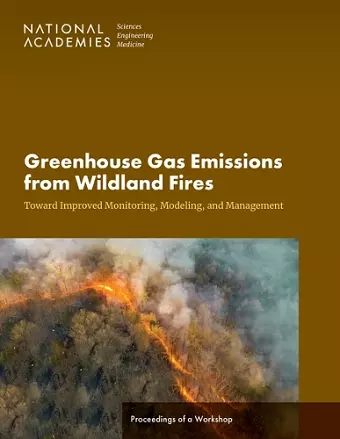Greenhouse Gas Emissions from Wildland Fires
Toward Improved Monitoring, Modeling, and Management: Proceedings of a Workshop
Division on Earth and Life Studies author Board on Agriculture and Natural Resources author Polar Research Board author Board on Atmospheric Sciences and Climate author National Academies of Sciences, Engineering, and Medicine author Committee on Greenhouse Gas Emissions from Wildland Fires: Toward Improved Monitoring, Modeling, and Management—A Workshop author Rachel Silvern editor
Format:Paperback
Publisher:National Academies Press
Published:29th Jun '24
Currently unavailable, and unfortunately no date known when it will be back

Climate change is fundamentally changing ecosystems and their fire conditions, and the 2023 fire season highlighted the urgency of developing and implementing solutions to address wildland fires. Wildland fires transfer carbon between the land and the atmosphere through emissions of greenhouse gases (GHGs), along with other gasses and particles. Though fires can be a natural part of healthy, evolving ecosystems, large, uncontrolled wildland fires can have devastating consequences to human health, communities, and biodiversity. Human-driven changes in wildland fire regimes have the potential to increase GHG emissions at a scale that could inhibit global efforts to achieve net-zero GHG emissions in the coming decades.
The National Academies of Sciences, Engineering, and Medicine convened a workshop on September 13-15, 2023, to identify opportunities to improve measurements and model projections of GHG emissions from wildland fires and discuss management practices that could be incorporated into current and future action plans. Participants emphasized the importance of learning from historic and current Indigenous fire management practices and centering Indigenous voices and leadership across all stages of fire management. Different global ecosystems - particularly temperate, boreal, and tropical biomes - have been impacted by climate and land use changes where historical fire regimes and the carbon balance have been disrupted. However, discussions highlighted the diverse set of available regionally differentiated and ecosystem-appropriate mitigation strategies. With improved understanding of fires and their GHG emissions, better information for mitigation and management, and incorporation of wildfire GHG emissions into national accounting mechanisms, practitioners, communities, and decision makers will be better equipped to prepare, adapt, and respond to future wildland fires.
Table of Contents- Front Matter
- Overview
- Introduction
- Biomes Vulnerable to Wildland Fires and Implications for Greenhouse Gas Emissions
- Observing and Modeling Wildland Fires and Their Greenhouse Gas Emissions: Opportunities and Challenges
- Future Management to Support Net-Zero Targets
- Closing Thoughts
- References
- Appendix A: Statement of Task
- Appendix B: Biographical Sketches of Committee Members
- Appendix C: Workshop Agenda <
ISBN: 9780309715539
Dimensions: unknown
Weight: unknown
94 pages